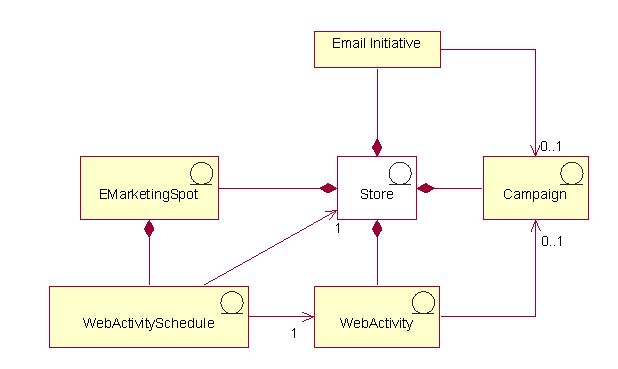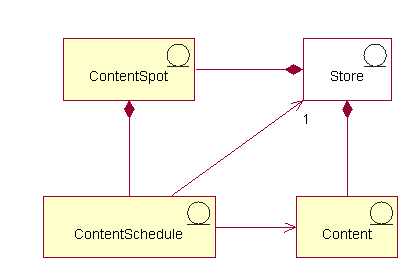Campaign assets
A Campaigns package. A campaign is a planned series of operations that include advertisements and suggestive selling techniques, that are pursued to achieve a defined set of business objectives. Campaigns are specific to a particular Store, and thus the Campaigns package is shown as dependent on the Store. Campaigns serve to organize your marketing efforts. Campaigns are typically created by a Marketing Manager. They are often associated with a certain set of objectives. For instance, a "Back to School" campaign can have an objective of increasing sales of children's clothes during the campaign.The following diagram illustrates the campaign assets in the Transaction Server:

Campaigns, and their associated assets are scoped to stores.
Within WebSphere Commerce, campaigns contain any number of Web activities, which define a
condition. The Web activities generate targeted content for the customers, when the defined
condition is evaluated to be true. The result is that a campaign is the high-level marketing element
that organizes the activities. The following diagram depicts the Web activity information model.

Campaign activities are associated with a campaign that contains a collection of activities. As an example of this relationship, if an office supply store had a "Back to School" campaign, the activities would be responsible for lower-level actions. For example, advertising a discount on pens, or suggesting lined paper to any customer that is registered and has a listed occupation as a student.
Campaign activities can display four types of dynamic content:
- Suggestive selling activities
- Collaborative filtering-based recommendation
- Awareness advertisement
- Merchandising association
Suggestive selling content provides rule-based category and product recommendations. These recommendations are targeted at a specific customer audience, which is based on a customer segment, and customer behavior. The customer behavior that a campaign can target includes the total value or contents of the shopping cart, and the contents of the customer purchase history.
Collaborative filtering-based recommendations also create product recommendations. These filtering-based recommendations use a different recommendation algorithm, which targets items that are based on the overall behavior of a customer, rather than predefined rules.
Awareness advertisements provide content that is targeted at a specific customer audience. This
audience is based on the same criteria used for suggestive selling, but the advertisements
are intended to be used to increase a customer's awareness about activities at the online store,
highlight special offers, and to increase brand awareness. Awareness advertisements follow the content information model that is shown here:

Merchandising associations create up-sell and cross-sell opportunities, which are based on the static associations that are defined in the catalog. To create an activity of this type, a method of selecting the source product in the association must be defined. Defining the association is necessary so that the proper source is used when the e-Marketing Spot is invoked, to return the target products. The method can select the source that is based on either the content of the current page, the contents of the shopping cart, or the contents of the shopper purchase history, as sources of the association.
Activities can be incorporated into any page on the site. When the site is designed, special placeholders, called e-Marketing Spots, are placed on the site. When displayed to a customer, these placeholders are replaced by the specific targeted content. Target locations are assigned by scheduling activities to display in e-Marketing Spots in the wanted locations.
Web activities contain a condition that determines when and to whom they are displayed. This condition is defined when the activity is created. This condition can be changed during the lifetime of the activity to adjust the activity visibility and the displayed content.
Web activities generate statistics about their use. The statistics illustrate an activity clickthrough rate for each e-Marketing Spot where it is implemented. These statistics provide feedback on the effectiveness of the activity, and comparative success rates among the various locations in which it displays.
Related concepts
Store data information model